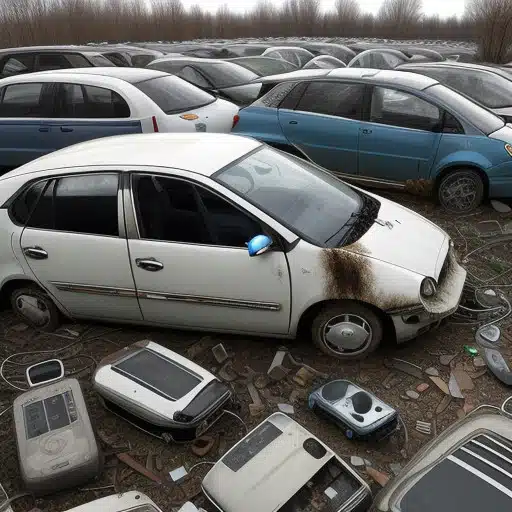
EVs are a Disaster and There was a Much Better Clean Energy Alternative
Even though he’s old and senile, Joe Biden really is the perfect representation of a woke leftist.
Just like the broader movement, everything Biden touches turns to shit.
Right now, inflation and the border use up most of the oxygen in the room, but that’s a shame because there are several other issues that highlight Biden’s incompetency in a way that would likely change the minds of a few liberals, some independents and many moderate Republicans.
Here is an example of a major Biden policy failure that mostly flies under the radar.
EVs
Look, I have no problem with electric vehicles as a novelty item so rich people can feel like they’re saving the planet. Good for Elon that he had the vision and fortitude to turn an idea into a mega corporation, and if he was able to take advantage of government ignorance to persuade them to shell out $2.4 billion in grants and tax credits for Tesla, that’s even better. After all, he simply tapped into the “I want to make a difference” culture that woke zealots have created to feel better about themselves.
Yet, in the rush to “save the planet,” the Biden government and leftist governors like Gavin Newsom dumped draconian tailpipe mandates on an unsuspecting public, effectively banning internal combustion engine (ICE) vehicles by 2032 . This caused the auto industry to collectively hyperventilate, and as with all things Biden, the regulations were rolled out without any consideration of unintended consequences.
In short, EVs are proving to be a disaster in the making, and the demand for this flawed technology is plummeting. A recent American Automobile Association survey shows that 63% of Americans are “unlikely or very unlikely” to purchase an EV in the near future. Issues cited in the study include range anxiety, charging station reliability, battery failure in extreme temperatures, charging times and cost.
As the EV scam continues to unravel, consumers will begin to understand the unmitigated disaster mass adoption of the technology would trigger from an environmental standpoint. This includes the mining of toxic metals in underdeveloped countries that use child labor, no realistic plan for disposal or recycling millions of toxic EV batteries every year, 74% greater CO2 emissions during manufacturing, and a study that determined particulate matter emissions from EV tires are 1850 times greater than ICE engine tailpipe emissions.
Synthetic Fuel: The Inexpensive Solution
Let’s say for the sake of argument climate change is real, and let’s say that it might be human caused, so we want to do something to reduce emissions. Invariably, that means involving the government handing out money to develop technology to address the issue.
Wouldn’t it make sense to explore the options that would be least disruptive to the lives of ordinary Americans and the transportation industry before blowing the whole thing up and starting from scratch?
Which got me to thinking: Is it plausible to create a zero emissions fuel compatible with existing ICE vehicles that could replace petroleum-based gasoline? This idea seemed so fundamentally obvious I was certain that I would find a whole slew of barriers that would prohibit development, let alone adoption, on a large-scale level.
But I was wrong.
In fact, synthetic fuel already exists, and the industry has focused its efforts on one specific technology. Three companies are leading the effort to develop environmentally friendly synthetic fuels that can be burned in ICE vehicles without any modifications. Yep, you read that right. The method involves extracting hydrogen from H2O and blending it with captured CO2 to form methanol, which can then be refined into synthetic gasoline. Synthetic fuel has the potential to reduce overall vehicle emissions by 70-90%.
And the best part? Current ICE auto assembly lines would require few, if any, modifications.
Aramco, a Saudi oil and chemicals company, entered into a partnership with NEOM, an energy and water company to construct a demonstration plant for the production of synthetic fuel.
Porsche and Siemens Energy have developed a synthetic fuel that is currently in production. Brought online in early 2023, the $100 million plant in Punta Arenas, Chile is scheduled to produce 55 million liters of synthetic fuel per year within three years at a cost of about $2 per liter or $7.50/gallon.
HIF Global is the largest producer of synthetic fuel in the world. They have an online operation in Latam, Chile and are in the process of building a plant in Matagorda, Texas that will produce 1.4 million tons of eMethanol by 2027.
Joe Biden’s Major Clean Energy Policy Mistake
No one can provide an accurate estimate of the cost to transition the entire fleet of ICE vehicle to EVs in the U.S. Estimates range from hundreds of billions to trillions of dollars. This does not account for expense and inconvenience average Americans will have to endure as a result of the conversion.
And for what? The hope that humans are causing climate change, which hasn’t been confirmed by a single experiment.
At present, the federal government alone has allocated $30.5 billion for EV development, including a national network of charging stations, battery production, EV component manufacturing, rebates and incentives.
Conversely, during the same period, the government only spent $121 million on synthetic fuel development, half of which was targeted for synthetic aviation fuel.
Think about that for a moment. Biden and his cronies have invested less than 1% of the amount they’ve plowed into the EV sinkhole on synthetic fuel. And remember, most drivers won’t even consider buying an EV, and they’re an environmental disaster.
If Porsche can produce synthetic fuel for $7.50/gallon on a small scale, how much could that price be reduced if the fuel went into mass production? How much eFuel could be generated with an investment of half of what has been sunk into EV development? How much could the efficiency of the fuel be improved, and how much stress, inconvenience, and expense could the American consumer avoid by filling up their existing vehicle with a clean burning, environmentally friendly fuel?
Yeh, yeah, I know the woke leftists will come unglued because for some reason, they worship the idea of everything running on electricity, but until I hear the experts at Porsche, Aramco and HIF tell us why synthetic fuel cannot be produced at economies of scale, I’ll believe an enormous opportunity to accomplish two national priorities simultaneously was squandered. An investment at the same level as current EV funding would allow for fuel price incentives, public/private partnerships, infrastructure development, renewable energy integration, scalability and efficiency improvements.
Let’s hope Trump exploits this low hanging fruit issue and then kills off the EV boondoggle once he takes office.


